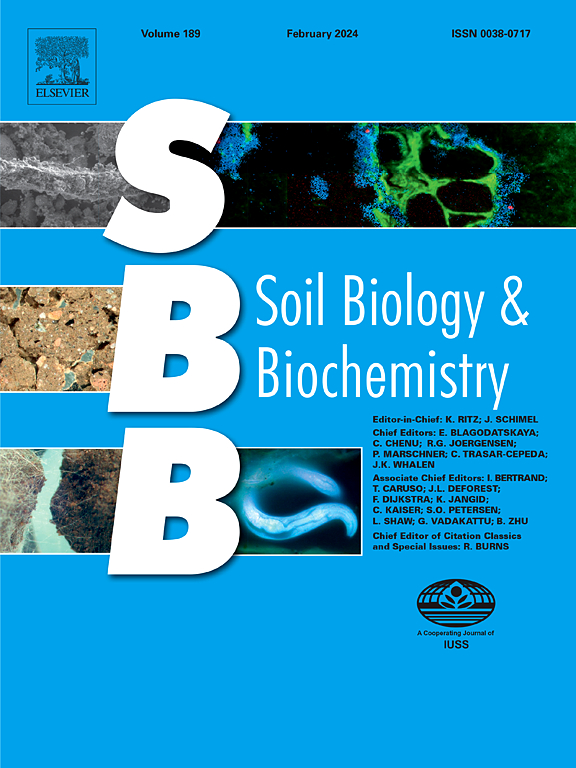Biochar strategy for long-term N2O emission reduction: Insights into soil physical structure and microbial interaction
IF 10.3
1区 农林科学
Q1 SOIL SCIENCE
引用次数: 0
Abstract
Applying biochar to agricultural soils is a promising strategy for mitigating nitrous oxide (N2O) emissions. Nitrogen (N) fertilizers are essential for crop production but also represent a significant source of N2O emissions. The effectiveness of biochar in reducing N2O emissions depends on the amount of N fertilizer applied and the morphological structure of the biochar. However, few studies have examined the impact of field-aged biochar on N₂O emissions under different N application levels, especially concerning the mechanisms by which biochar's morphological properties and soil characteristics influence microbial-driven N₂O production. We conducted a long-term field experiment over three winter wheat seasons, applying two N fertilizer doses (113.25 and 226.5 kg N ha−1) and four biochar doses (0, 5, 10, 20 t ha−1). In-situ N₂O measurements, combined with amplicon sequencing (16S rRNA, ITS rRNA), metagenomic sequencing, scanning electron microscopy, and Brunauer-Emmett-Teller analysis, were performed to explore the effects of combined application of biochar with N fertilizer on soil N₂O emissions and potential soil physicochemical and microbial mechanisms. The study demonstrated that biochar aged for several years consistently reduced soil N2O emissions, likely due to modifications in soil physical properties such as specific surface area, pore size, and pore volume. The dose of N fertilizer had a significant effect on how biochar regulated soil pore structure, consequently impacting the abundance of N cycle genes and microbes. The intermediate biochar dose of 10 t ha−1 biochar significantly increased soil mesopore size and the abundance of N2O-reducing genes such as nosZ, while simultaneously suppressing the N2O production genes such as napA and norB through enhanced soil specific surface area and pore volume, but further increasing the dose did not result in sustained improvement. The functional diversity of N-cycling genes proved to be a more reliable predictor of N2O emissions than the diversity of fungal and bacterial taxa. Our findings advance the understanding of how biochar influences physical-microbial interactions that determine N2O production in agricultural soils. These mechanistic insights are crucial for developing integrated biochar and fertilization management strategies to mitigate climate change effectively.


长期减少N2O排放的生物炭策略:对土壤物理结构和微生物相互作用的见解
将生物炭应用于农业土壤是减少一氧化二氮(N2O)排放的一种有前途的策略。氮肥对作物生产至关重要,但也是N2O排放的重要来源。生物炭减少N2O排放的效果取决于施氮量和生物炭的形态结构。然而,很少有研究考察不同施氮水平下田间陈化生物炭对N₂O排放的影响,特别是关于生物炭形态特征和土壤特征对微生物驱动的N₂O产生的影响机制。在3个冬小麦季节进行了长期田间试验,施用2个氮肥剂量(113.25和226.5 kg N ha-1)和4个生物炭剂量(0、5、10和20 t ha-1)。采用原位N₂O测量、扩增子测序(16S rRNA、ITS rRNA)、宏基因组测序、扫描电镜和brunauer - emmet - teller分析等方法,探讨了生物炭与氮肥配施对土壤N₂O排放的影响及其潜在的土壤理化和微生物机制。该研究表明,经过数年老化的生物炭持续减少了土壤N2O的排放,这可能是由于土壤的物理性质(如比表面积、孔径和孔容)发生了变化。施氮量对生物炭调控土壤孔隙结构的方式有显著影响,从而影响氮素循环基因和微生物的丰度。10 t ha-1生物炭的中间剂量显著增加了土壤中孔大小和nosZ等N2O还原基因的丰度,同时通过增加土壤比表面积和孔体积抑制了napA和norB等N2O生成基因,但进一步增加剂量并不能持续改善。氮循环基因的功能多样性比真菌和细菌分类群的多样性更能预测N2O排放。我们的研究结果促进了对生物炭如何影响决定农业土壤N2O产量的物理-微生物相互作用的理解。这些机制见解对于制定生物炭和施肥综合管理战略以有效减缓气候变化至关重要。
本文章由计算机程序翻译,如有差异,请以英文原文为准。
求助全文
约1分钟内获得全文
求助全文
来源期刊

Soil Biology & Biochemistry
农林科学-土壤科学
CiteScore
16.90
自引率
9.30%
发文量
312
审稿时长
49 days
期刊介绍:
Soil Biology & Biochemistry publishes original research articles of international significance focusing on biological processes in soil and their applications to soil and environmental quality. Major topics include the ecology and biochemical processes of soil organisms, their effects on the environment, and interactions with plants. The journal also welcomes state-of-the-art reviews and discussions on contemporary research in soil biology and biochemistry.
 求助内容:
求助内容: 应助结果提醒方式:
应助结果提醒方式:


